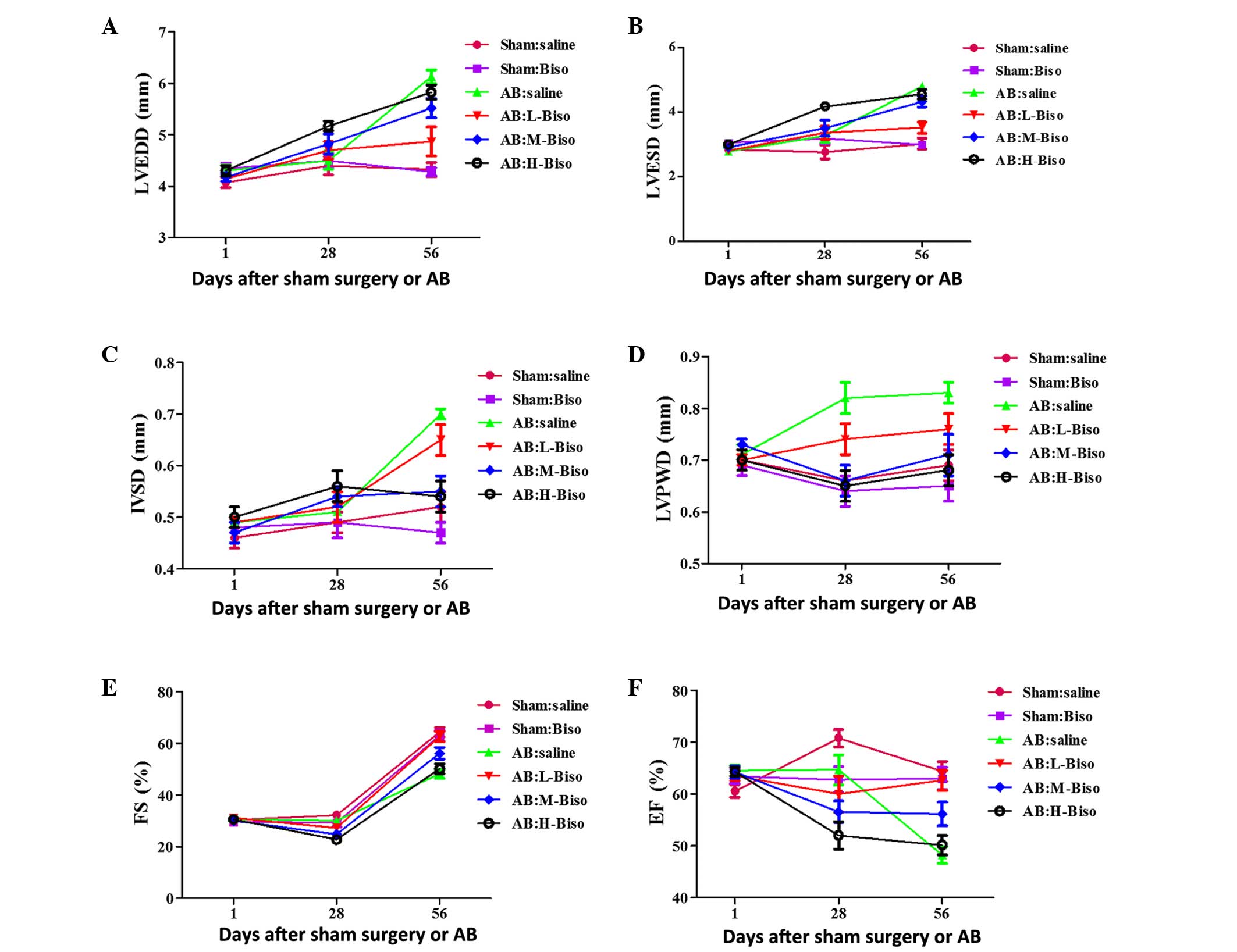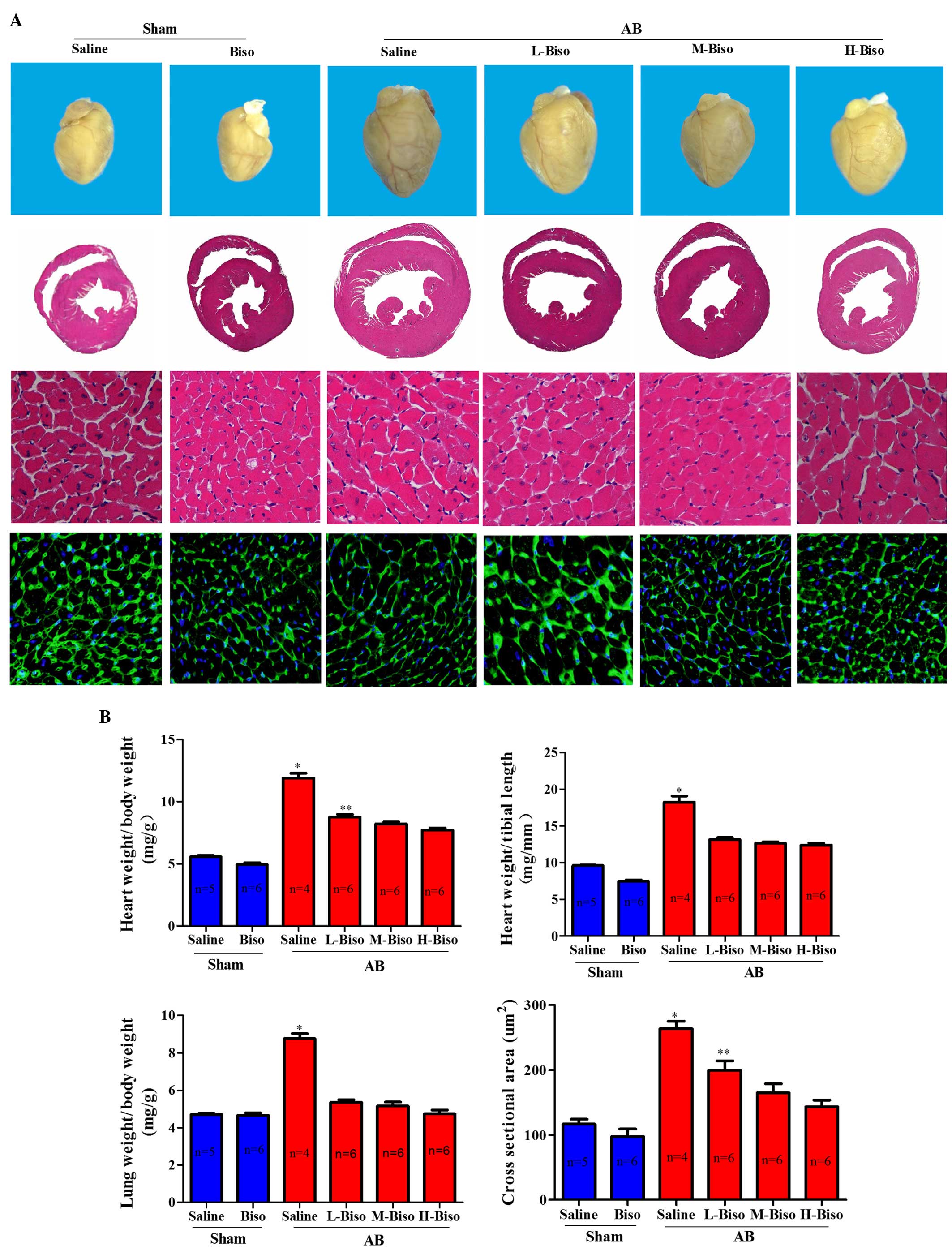|
1
|
LloydJones D, Adams RJ, Brown TM,
Carnethon M, Dai S, De Simone G, Ferguson TB, Ford E, Furie K,
Gillespie C, et al: American Heart Association Statistics Committee
and Stroke Statistics Subcommittee: Executive summary: Heart
disease and stroke statistics - 2010 update: A report from the
American Heart Association. Circulation. 121:948–954. 2010.
View Article : Google Scholar : PubMed/NCBI
|
|
2
|
Lohse MJ, Engelhardt S and Eschenhagen T:
What is the role of beta-adrenergic signaling in heart failure?
Circ Res. 93:896–906. 2003. View Article : Google Scholar : PubMed/NCBI
|
|
3
|
Yang J, Liu Y, Fan X, Li Z and Cheng Y: A
pathway and network review on beta-adrenoceptor signaling and beta
blockers in cardiac remodeling. Heart Fail Rev. 19:799–814. 2014.
View Article : Google Scholar : PubMed/NCBI
|
|
4
|
Tzingounis AV, von Zastrow M and Yudowski
GA: {Beta}-blocker drugs mediate calcium signaling in native
central nervous system neurons by {beta}-arrestin-biased agonism.
Proc Natl Acad Sci USA. 107:21028–21033. 2010. View Article : Google Scholar : PubMed/NCBI
|
|
5
|
Gheorghiade M, Albert NM, Curtis AB,
Thomas Heywood J, McBride ML, Inge PJ, Mehra MR, O'Connor CM,
Reynolds D, Walsh MN, Yancy CW and Fonarow GC: Medication dosing in
outpatients with heart failure after implementation of a
practice-based performance improvement intervention: Findings from
IMPROVE HF. Congest Heart Fail. 18:9–17. 2012. View Article : Google Scholar : PubMed/NCBI
|
|
6
|
Shen DF, Tang QZ, Yan L, Zhang Y, Zhu LH,
Wang L, Liu C, Bian ZY and Li H: Tetrandrine blocks cardiac
hypertrophy by disrupting reactive oxygen species-dependent ERK1/2
signalling. Br J Pharmacol. 159:970–981. 2010. View Article : Google Scholar : PubMed/NCBI
|
|
7
|
Bian Z, Cai J, Shen DF, Chen L, Yan L,
Tang Q and Li H: Cellular repressor of E1A-stimulated genes
attenuates cardiac hypertrophy and fibrosis. J Cell Mol Med.
13:1302–1313. 2009. View Article : Google Scholar : PubMed/NCBI
|
|
8
|
Bian ZY, Huang H, Jiang H, Shen DF, Yan L,
Zhu LH, Wang L, Cao F, Liu C, Tang QZ and Li H: LIM and
cysteine-rich domains 1 regulates cardiac hypertrophy by targeting
calcineurin/nuclear factor of activated T cells signaling.
Hypertension. 55:257–263. 2010. View Article : Google Scholar : PubMed/NCBI
|
|
9
|
Novoyatleva T, Schymura Y, Janssen W,
Strobl F, Swiercz JM, Patra C, Posern G, Wietelmann A, Zheng TS,
Schermuly RT and Engel FB: Deletion of Fn14 receptor protects from
right heart fibrosis and dysfunction. Basic Res Cardiol.
108:3252013. View Article : Google Scholar : PubMed/NCBI
|
|
10
|
Noguchi A, Nakamura K, Sakata K,
SatoFukuda N, Ishigaki T, Mano J, Takabatake R, Kitta K, Teshima R,
Kondo K, et al: Development and interlaboratory validation of a
simple screening method for genetically modified maize using a
ΔΔCq-based multiplex real-time PCR assay. Anal Chem. 88:4285–4293.
2016. View Article : Google Scholar : PubMed/NCBI
|
|
11
|
Eghbali M and Weber KT: Collagen and the
myocardium: Fibrillar structure, biosynthesis and degradation in
relation to hypertrophy and its regression. Mol Cell Biochem.
96:1–14. 1990. View Article : Google Scholar : PubMed/NCBI
|
|
12
|
Daniels A, van Bilsen M, Goldschmeding R,
van der Vusse GJ and van Nieuwenhoven FA: Connective tissue growth
factor and cardiac fibrosis. Acta Physiol (Oxf). 195:321–338. 2009.
View Article : Google Scholar : PubMed/NCBI
|
|
13
|
RuizOrtega M, Rodríguez-Vita J,
Sanchez-Lopez E, Carvajal G and Egido J: TGF-beta signaling in
vascular fibrosis. Cardiovasc Res. 74:196–206. 2007. View Article : Google Scholar : PubMed/NCBI
|
|
14
|
Giordano FJ: Oxygen, oxidative stress,
hypoxia, and heart failure. J Clin Invest. 115:500–508. 2005.
View Article : Google Scholar : PubMed/NCBI
|
|
15
|
Belge C, Hammond J, DuboisDeruy E, Manoury
B, Hamelet J, Beauloye C, Markl A, Pouleur AC, Bertrand L, Esfahani
H, et al: Enhanced expression of β3-adrenoceptors in cardiac
myocytes attenuates neurohormone-induced hypertrophic remodeling
through nitric oxide synthase. Circulation. 129:451–462. 2014.
View Article : Google Scholar : PubMed/NCBI
|
|
16
|
Heineke J and Molkentin JD: Regulation of
cardiac hypertrophy by intracellular signalling pathways. Nat Rev
Mol Cell Biol. 7:589–600. 2006. View
Article : Google Scholar : PubMed/NCBI
|
|
17
|
Hill JA and Olson EN: Cardiac plasticity.
N Engl J Med. 358:1370–1380. 2008. View Article : Google Scholar : PubMed/NCBI
|
|
18
|
Drazner MH: The progression of
hypertensive heart disease. Circulation. 123:327–334. 2011.
View Article : Google Scholar : PubMed/NCBI
|
|
19
|
Lohse MJ, Engelhardt S and Eschenhagen T:
What is the role of beta-adrenergic signaling in heart failure?
Circ Res. 93:896–906. 2003. View Article : Google Scholar : PubMed/NCBI
|
|
20
|
Port JD and Bristow MR: Altered
beta-adrenergic receptor gene regulation and signaling in chronic
heart failure. J Mol Cell Cardiol. 33:887–905. 2001. View Article : Google Scholar : PubMed/NCBI
|
|
21
|
Mason RP, Giles TD and Sowers JR: Evolving
mechanisms of action of beta blockers: Focus on nebivolol. J
Cardiovasc Pharmacol. 54:123–128. 2009. View Article : Google Scholar : PubMed/NCBI
|
|
22
|
Yang J, Liu Y, Fan X, Li Z and Cheng Y: A
pathway and network review on beta-adrenoceptor signaling and beta
blockers in cardiac remodeling. Heart Fail Rev. 19:799–814. 2014.
View Article : Google Scholar : PubMed/NCBI
|
|
23
|
McMurray JJ, Adamopoulos S, Anker SD,
Auricchio A, Böhm M, Dickstein K, Falk V, Filippatos G, Fonseca C,
Gomez-Sanchez MA, et al: ESC Committee for Practice Guidelines: ESC
Guidelines for the diagnosis and treatment of acute and chronic
heart failure 2012: The Task Force for the Diagnosis and Treatment
of Acute and Chronic Heart Failure 2012 of the European Society of
Cardiology. Developed in collaboration with the Heart Failure
Association (HFA) of the ESC. Eur Heart J. 33:1787–1847. 2012.
View Article : Google Scholar : PubMed/NCBI
|
|
24
|
Writing Committee Members, . Yancy CW,
Jessup M, Bozkurt B, Butler J, Casey DE Jr, Drazner MH, Fonarow GC,
Geraci SA, Horwich T, et al: American College of Cardiology
Foundation/American Heart Association Task Force on Practice
Guidelines. 2013 ACCF/AHA guideline for the management of heart
failure: A report of the American College of cardiology
Foundation/American Heart Association task force on practice
guidelines. Circulation. 128:e240–e327. 2013. View Article : Google Scholar : PubMed/NCBI
|
|
25
|
Lee DS, Tu JV, Juurlink DN, Alter DA, Ko
DT, Austin PC, Chong A, Stukel TA, Levy D and Laupacis A:
Risk-treatment mismatch in the pharmacotherapy of heart failure.
JAMA. 294:1240–1247. 2005. View Article : Google Scholar : PubMed/NCBI
|
|
26
|
Poldermans D, Boersma E, Bax JJ, et al:
Expression of concern relating to: ‘Bisoprolol reduces cardiac
death and myocardial infarction in high-risk patients as long as 2
years after successful major vascular surgery’. Eur Heart J. doi:
10.1093/eurheartj/ehu397.
|
|
27
|
van der Wall EE: Beta-blocking agents in
cardiovascular disease; are they here to stay? Neth Heart J.
22:481–483. 2014. View Article : Google Scholar : PubMed/NCBI
|
|
28
|
Imamura T, Kinugawa K, Hatano M, Fujino T,
Muraoka H, Inaba T, Maki H, Kagami Y, Endo M, Kinoshita O, et al:
Preoperative beta-blocker treatment is a key for deciding left
ventricular assist device implantation strategy as a bridge to
recovery. J Artif Organs. 17:23–32. 2014. View Article : Google Scholar : PubMed/NCBI
|
|
29
|
Patel K, Fonarow GC, Ekundayo OJ, Aban IB,
Kilgore ML, Love TE, Kitzman DW, Gheorghiade M, Allman RM and Ahmed
A: Beta-blockers in older patients with heart failure and preserved
ejection fraction: Class, dosage, and outcomes. Int J Cardiol.
173:393–401. 2014. View Article : Google Scholar : PubMed/NCBI
|
|
30
|
Jacob SM, Chandy TT and Cherian VT: Oral
bisoprolol improves surgical field during functional endoscopic
sinus surgery. J Anaesthesiol Clin Pharmacol. 30:59–64. 2014.
View Article : Google Scholar : PubMed/NCBI
|
|
31
|
Tanaka H, Matsumoto K, Sawa T, Miyoshi T,
Motoji Y, Imanishi J, Mochizuki Y, Tatsumi K and Hirata K:
Evaluation of global circumferential strain as prognostic marker
after administration of β-blockers for dilated cardiomyopathy. Int
J Cardiovasc Imaging. 30:1279–1287. 2014. View Article : Google Scholar : PubMed/NCBI
|
|
32
|
Cruickshank JM: Are we misunderstanding
beta-blockers. Int J Cardiol. 120:10–27. 2007. View Article : Google Scholar : PubMed/NCBI
|
|
33
|
Nakaya M, Chikura S, Watari K, Mizuno N,
Mochinaga K, Mangmool S, Koyanagi S, Ohdo S, Sato Y, Ide T, et al:
Induction of cardiac fibrosis by β-blocker in G protein-independent
and G protein-coupled receptor kinase 5/β-arrestin2-dependent
signaling pathways. J Biol Chem. 287:35669–35677. 2012. View Article : Google Scholar : PubMed/NCBI
|
|
34
|
Berk BC, Fujiwara K and Lehoux S: ECM
remodeling in hypertensive heart disease. J Clin Invest.
117:568–575. 2007. View Article : Google Scholar : PubMed/NCBI
|
|
35
|
Burchfield JS, Xie M and Hill JA:
Pathological ventricular remodeling: Mechanisms: Part 1 of 2.
Circulation. 128:388–400. 2013. View Article : Google Scholar : PubMed/NCBI
|
|
36
|
Porter KE and Turner NA: Cardiac
fibroblasts: At the heart of myocardial remodeling. Pharmacol Ther.
123:255–278. 2009. View Article : Google Scholar : PubMed/NCBI
|
|
37
|
Bujak M and Frangogiannis NG: The role of
TGF-beta signaling in myocardial infarction and cardiac remodeling.
Cardiovasc Res. 74:184–195. 2007. View Article : Google Scholar : PubMed/NCBI
|
|
38
|
Huang XR, Chung AC, Yang F, Yue W, Deng C,
Lau CP, Tse HF and Lan HY: Smad3 mediates cardiac inflammation and
fibrosis in angiotensin II-induced hypertensive cardiac remodeling.
Hypertension. 55:1165–1171. 2010. View Article : Google Scholar : PubMed/NCBI
|
|
39
|
Li JM and Brooks G: Differential protein
expression and subcellular distribution of TGFbeta1, beta2 and
beta3 in cardiomyocytes during pressure overload-induced
hypertrophy. J Mol Cell Cardiol. 29:2213–2224. 1997. View Article : Google Scholar : PubMed/NCBI
|
|
40
|
Pauschinger M, Knopf D, Petschauer S,
Doerner A, Poller W, Schwimmbeck PL, Kühl U and Schultheiss HP:
Dilated cardiomyopathy is associated with significant changes in
collagen type I/III ratio. Circulation. 99:2750–2756. 1999.
View Article : Google Scholar : PubMed/NCBI
|
|
41
|
Fukui M, Goda A, Komamura K, Nakabo A,
Masaki M, Yoshida C, Hirotani S, LeeKawabata M, Tsujino T, Mano T
and Masuyama T: Changes in collagen metabolism account for
ventricular functional recovery following beta-blocker therapy in
patients with chronic heart failure. Heart Vessels. 31:173–182.
2016. View Article : Google Scholar : PubMed/NCBI
|
|
42
|
Lenneman AJ and Birks EJ: Treatment
strategies for myocardial recovery in heart failure. Curr Treat
Options Cardiovasc Med. 16:2872014. View Article : Google Scholar : PubMed/NCBI
|
|
43
|
Lund LH, Benson L, Dahlström U, Edner M
and Friberg L: Association between use of β-blockers and outcomes
in patients with heart failure and preserved ejection fraction.
JAMA. 312:2008–2018. 2014. View Article : Google Scholar : PubMed/NCBI
|
|
44
|
Apostolovic S, Stanojevic D, Lainscak M,
Gelbrich G, JankovicTomasevic R, Pavlovic M, DjordjevicRadojkovic
D, SalingerMartinovic S, Putnikovic B, Radovanovic S, et al:
Regional differences among female patients with heart failure from
the cardiac insufficiency bisoprolol study in ELDerly (CIBIS-ELD).
Cardiol J. 21:265–272. 2014. View Article : Google Scholar : PubMed/NCBI
|
|
45
|
Fazio G, Vernuccio F, Lo Re G, Grutta G
and Mongiovì M: Role of bisoprolol in patients with long QT
syndrome. Ann Noninvasive Electrocardiol. 18:467–470. 2013.
View Article : Google Scholar : PubMed/NCBI
|
|
46
|
Sorrentino SA, Doerries C, Manes C, Speer
T, Dessy C, Lobysheva I, Mohmand W, Akbar R, Bahlmann F, Besler C,
et al: Nebivolol exerts beneficial effects on endothelial function,
early endothelial progenitor cells, myocardial neovascularization,
and left ventricular dysfunction early after myocardial infarction
beyond conventional β1-blockade. J Am Coll Cardiol. 57:601–611.
2011. View Article : Google Scholar : PubMed/NCBI
|



















